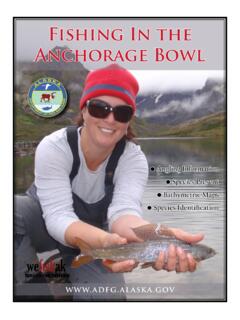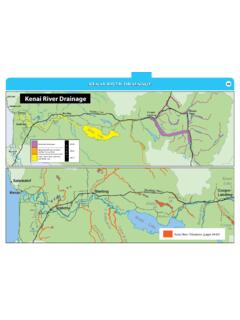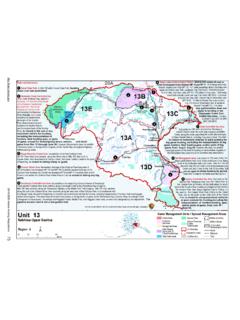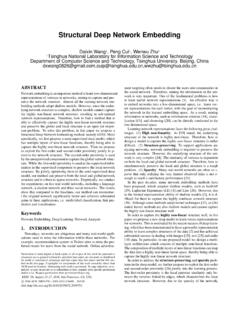Transcription of Appendix A. Units of Measure, Scientific Abbreviations ...
1 119 Appendix AAppendix A: Units of Measure, Scientific Abbreviations , Symbols, Conversions, Variables, and EquationsThese Abbreviations are for Scientific and technical writing, and are not applicable to general style. Technical Abbreviations should be used only in conjunction with a number or in a table heading; spell out most text uses not associated with a number. If your audience is nontechnical, introduce these Abbreviations (spell out in full on first use and put the abbreviation beside it in parentheses) or avoid the abbreviation entirely. Most of these technical Abbreviations are international standards from Sys-t me Interna tional d Unit s and the CSE manual, Scientific Style and Format (CSE 2006).In Scientific writing, do not add s to a symbol for a unit of measure. Both single and plural are indicated by use of the symbol Abbreviations , Conversions, and SymbolsWeights and Measures (English)acrea ( ha)cubic feet per second ( m3/s) ft3/s fathoma ( m or 6 ft)foot ( cm) ftgallon ( L) galinchb inknot ( m /s) knmile ( km) minautical milec (1,852 m or km) nmi ounce ( g) ozpound ( kg or 454 g) lbquart ( L) qttona (2,000 lb or kg)yard ( m or cm) ydWeights and Measures (Metric)centimeter ( in) cmgram ( oz) ghectare ( acres) hakilogram ( lb) kgkilometer ( mi) kmliterd ( gal, qt) Lmeter ( yd, ft, in) mmicrometer (do not use micron) mmillimeter ( in) mmmilliliter mLtonnee(1,000 kg or 2,205 lb) tTime and Temperatureday ddegrees Celsiusf ([ F 32] ) C degrees Fahrenheitf ([ C]+32) Fdegrees Kelvinf (K = C + ) Khour (spell out for 24-hour time of day) hminute minmonthasecond sweekayear yPrefixesgiga (109) Gkilo (103) kmega (106) Mmilli (10 3) mmicro (10 6) nano (10 9)
2 N120 Appendix Aa No abbreviation; spell out. b Only used with a number Should be introduced on first use ( , spell out in full on first use and insert the abbreviation beside it in parentheses), or spelled out throughout document. d In less technical contexts the symbol is often given as a lowercase l. This exception only applies to this symbol, not to other metric Metric ton may be used instead; its abbreviation (mt) may be used, but it should be introduced. f Close up the space when used in conjunction with numbers expressing longitude/latitude, angles, and degrees ( , 45 F). g Symbol or abbreviation is If you prefer, you may use SE for standard error, SD for standard deviation, or var for vari ance or a unique abbreviation for mean ( , other than x ); however, these Abbreviations should be introduced on first use. Note that s is the parameter and s is the and Statisticsanalysis of variance ANOVA approximately ~base of natural logarithm echi-square c2coefficient of variation CVcommon test statistics (F, t, c2, etc.)
3 Confidence intervalc CIcorrelation coefficient (multiple)g Rcorrelation coefficient (simple)g rcovariancec covdegree (angular or temperature)f degrees of freedom dflogarithms base 10 log base x logx natural lnnull hypothesisc H0alternative hypothesis c HAmeanc, h xminute (angular) not significant NS percent %population sizeg Nprobabilityg Psample sizeg nsignificance probability c, g P-valstandard deviationh s or sstandard errorh (of the mean) g sxvariance c s2 or s2 Physics and Chemistryany atomic symbol may be usedalternating current acampere ABritish thermal unit ( J) Btucalories (should be converted to joules in the metric system, see joule)chemical acronyms listed in Webster s dictionary (DDT, EDTA, etc.) may be useddirect current dcfootcandle ( lx) fchertz Hzhydrogen ion activity (negative log of) pH joule ( gram -calories or Btu) J lux ( fc) lxmolar Mmole molnewton Nnormal N or n ohm ortho opara ppascal Paparts per million (per 106 in the metric system, use mg/L, mg/kg, etc.)
4 Ppmparts per thousand (per 103) ppt, siemens Svolt Vwatt W121 Appendix Variables and Mathematical SymbolsUse the following symbols for common mathematical symbols:SymbolMeaningRemarksExamples+plu s, add minus, subtract or multiplied by, timesalso shown by juxtaposition of the quantities15n; 15 25/; divided byavoid xy 1; our readership is not entirely technical, and this usage is not part of common languagex/y or 95 sum equal to or greater than equal to or less than>greater than<less than plus or minusWhen used with numbers or variable symbols, set off common mathematical operators (plus, minus, times, and division) and all the equality and inequality symbols from variables and numerals with a space. When these symbols are modifying a number rather than serving as operators, close them up to the numeral or write them out. a. Spacing of mathematical symbols Mathematical symbols should not be used as a shorthand for words, to begin a sentence, or between two words in running text.
5 Two or more mathematical operators should not appear side by side. Mathematical symbols in adjacent mathematical expressions should be separated by words or punctuation, because it may be difficult to tell where one expression ends and another : biomass of 500 g (a 1) > y x > y < z at a = but when a > at 50 gravity but 50 magnification Use: at greater than 6 F Avoid: > 6 F or > 6 FUse: the target zone equals the optimum plus : the target zone = the optimum + spaces between quantities multiplied : 2xyClose spaces between fence brackets and the variables on either side of them:Use: (a 1)y (4p + 4bc)(1 a) a[x]122 Appendix Ab. Other number standardsA mixture of numerals and spelled-out numbers can be used to express very large numbers (millions or more).Try to avoid using text strings of individual numbers that are separated by com-mas or semicolons; these constructions can cause Significant digitsThe correct number of significant digits should be used in reported numbers.
6 In general, the number of digits in a reported measurement implies that the true value lies within a range, the width of which is determined by the last decimal place in the measurement. Thus, a value of 5 cm implies a range of accuracy of 1 cm whereas a value of cm implies a range of cm. The significant digits in a computed value should not exceed that of the value in the computation with the least number of significant digits. Thus if fish lengths were measured to the nearest centimeter, average length should also be rounded to a whole Statistical findingsInclude reference to the statistical method used for all relationships explained and validated in the results section through a statistical process. When reporting the results of statistical tests state the test method, associated significance probability (preferably as an equality), and, where appropriate, the degrees of should also consider and discuss biological significance of the results.
7 It is useful for the author to note when statistically significant results have limited biological relevance ( , a statistical significance value of 1 cm in fish length may not have biological significance).e. Using mathematical terms developed by othersSpecial terms or names for special mathematical expressions as used or defined by an author should be cited and the terminology used should be the same as the term originally used by the author, unless variations are clearly defined and explained. Use: We estimated potential fish production using Ryder s (1965) morphoedaphic index of EquationsEquations are sentences. The left hand side is the subject; the equal sign together with the right hand are the predicate. When you use equations, follow the same ad-vice you have been given about how to use other kinds of sentences. First, put the equation in a paragraph with a good topic sentence that focuses the reader.
8 Break 123 Appendix Acomplex ideas up into smaller parts and introduce and explain one important idea at a time. Also, because equations express a complete thought and contain a subject and a predicate, equations need appropriate punctuation. Usually, you should put the the most important idea you want the reader to remember at the end of a paragraph. For that reason, it is often a good idea to end a paragraph that introduces notation with a key you use equations, the point is to communicate. Use equations to visually show mathematical relationships. If you, the author, cannot quickly see the key re-lationships in an equation, then the equation is surely too complex for someone un-familiar with the topic, and the equation should be restated using a series of simpler equations. If you have a lot of complex notation, the reader might appreciate having the entire notation system in a single table. With or without this kind of table, it is always a good idea to remind the reader of the meaning of your notation if it has not been used within a few paragraphs.
9 Many readers will become confused if the equa-tion subscripts are not unique identifiers. For example, do not use i to designate fish in one equation and then to designate set in another equation. Equations should be used to help readers understand models and mathematical relationships. Do not waste your reader s time developing equations for common things that the reader already understands. Just cite commonly used statistical techniques, such as typical standard deviation equations, using standard references. All variable names should be in italics, and Units of measurements should not. In this way the reader should know that 5m means five times the variable named by m, and 5 m means five meters. The names of all standard statistical tests and other statistics contain variable names (for example, t-test, c2-distribution, P-val < ) and are itali-cized as are regression coefficients and acronyms when used as variable equations may be included in the text if the equation will fit legibly within the line spacing for the normal paragraph style.
10 These equations should not be numbered. You may wish to number key equations so that you can refer back to them by name. If you number equations, place the equation number in parentheses aligned with the right margin of the page. Complex equations displayed in documents prepared with the two-column template may be formatted to print across both columns. If the equation exceeds a single column width, do not wrap text around the equations. An example of a formatted, numbered equation follows: ( )( ) 1 1iiitiDDVar Dn = . (1)When typesetting an equation, take care that the symbols translate correctly when the document is submitted for review, editing, or Aa. Equation checklist1. Key concepts are introduced one at a time and fully explained before intro-ducing new It is easy to see key relationships by looking at the Variable names are in Units of measurement are in regular The equations have the correct Mathematical ideas are consistently called by one and only one name.












![arXiv:1607.04606v2 [cs.CL] 19 Jun 2017](/cache/preview/6/2/c/8/2/7/a/7/thumb-62c827a76726812cd50a8dd76dda0eb8.jpg)


